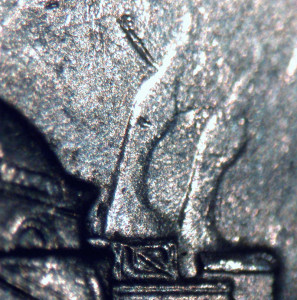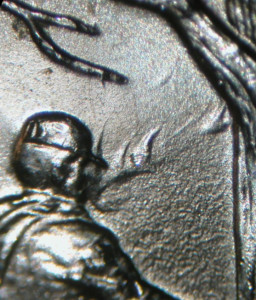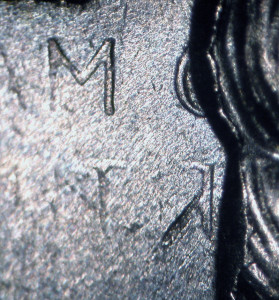Part IV. Die Errors:
Clashed Dies:
Raised Clash Marks
Definition: Clash marks are generated when dies collide in the absence of a planchet. Each die transfers part of its design to the opposite die in the form of faint, raised, normally-oriented design elements. Clash marks are generally confined to the field portion and shallowest devices of the die face.
While clash marks are expected to appear on a coin as incuse, mirror-image features, there are exceptions, both real and apparent.
Raised clash marks may occur in the event of a relatively light collision. If, on the die face, a narrow strip of field is situated between two relatively broad elements, only that narrow strip will make an (incuse) impression on the opposite die. The coin will therefore show a correspondingly raised, mirror-image design element.
Two “flames” erupt from the roof of Monticello on this 1983-P nickel. They represent a pair of identical, offset, raised clash marks that depict the gap between Jefferson’s neck and queue (“ponytail”).
The reverse face of this 2001-P Vermont quarter dollar shows a raised clash mark that has been whimsically interpreted as a vapor cloud emerging from the maple-tapper’s mouth. The “winter breath” clash mark is actually the area where Washington’s wig meets his neck.
Raised clash marks are also the inevitable result of a clash involving design elements intended to be incuse on a coin. The corresponding features on the die face are therefore raised, and they will penetrate the opposing die in the event of a clash. The resulting incuse, normally-oriented accessory design elements will be transferred to a coin as raised, mirror-image design elements.
The reverse design of the New Hampshire quarter contains the incuse legend OLD MAN OF THE MOUNTAIN. When transferred to the obverse die, they appear on the coin as raised, mirror-image letters. On this particular 2000-P New Hampshire quarter, behind Washington’s inverted head. we find the letters (OL)D MA(N) on the top line and (O)F TH(E) on the next line.


